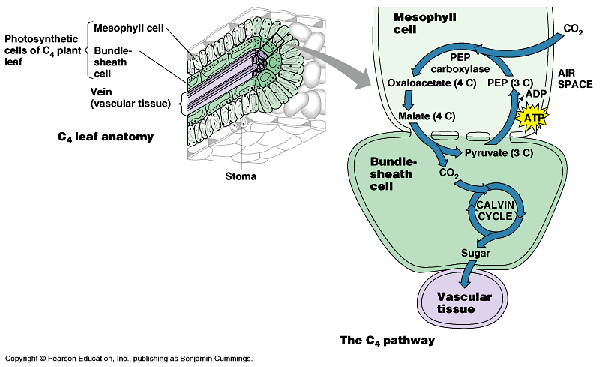– O2 competes with CO2 for rubisco’s active site
– rubisco catalyzes two reactions:
1) addition of carbon to RuBP; forms 2 PGA molecules (photosynthesis)
2) addition of oxygen to RuBP; forms 1 PGA and one glycolate (photorespiration)
– photorespiration decreases the production of carbohydrates by removing PGA from the Calvin cycle
– glycolate is partially converted to CO2 -> thus carbon fixation is reduced
– C4 adaptations work to reduce photorespiration
C4 Plants:
-several thousand species of plants undergo C4 photosynthesis
-enzyme PEP carboxylase catalyzes the addition of a CO2 molecule to a three-carbon molecule, forming a four-carbon molecule; hence being called C4
Structure:
-the leaves of C4 plants contain two types of photosynthetic cells: bundle-sheath cells surrounding a vein and mesophyll cells
How it works:
-in mesophyl cells, PEP carboxylase fixes CO2; PEP + CO2 -> OAA -> malate
-malate diffuses into bundle-sheath cells and CO2 portion is removed
-CO2 from malate enters the C3 Calvin cycle (the 2nd fixation reaction)
Purpose:
-continually pumps CO2 molecules into bundle-sheath cells, where rubisco brings them into the Calvin cycle
-keeps the CO2 concentratoin in the bundle sheath cells high so that CO2 outcompetes O2 for rubisco’s active site
Cost:
-costs the plant 2 ATP per molecule of CO2 transported; 12 extra ATP per molecule of glucose
CAM Plants
-occurs in water storing plants, such as cacti and pineapples
Structure:
-open their stomata at night and close them during the day; reverse of other plants
-closing stomata during the day helps conserve water but prevents CO2 from entering the leaves
How it works:
-in the dark, plants take in CO2 and make C4 organic acids
-organic acids are stored in vacuoles until morning
-organic acids release CO2 molecules that then enter the C3 Calvin cycle


